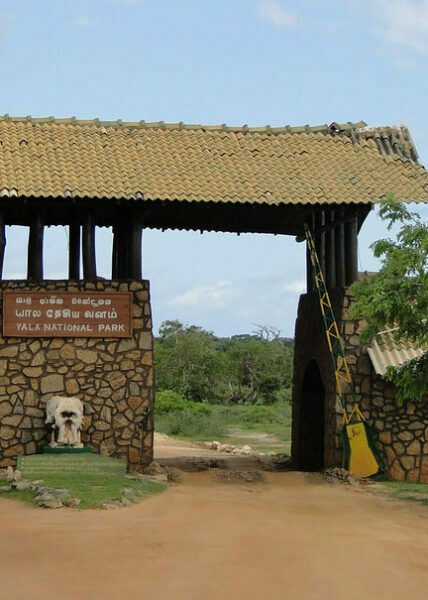Yala National Park is the most popular national park in Sri Lanka, with so many places to visit around. The park is around 260 kilometers from Colombo. Yala National Park has about 100,000 hectares of wildlife and borders Kirinda to the west, Kataragama to the north, Panama to the east, and the Indian Ocean to the south.
Although Sri Lankan leopards may be observed in several national parks around the nation, Yala National Park is said to be where the species is most common. The world’s largest leopard population density is said to reside in Yala. A herd of Asian Elephants, a sloth bear, a wild water buffalo, a toque, a golden palm civet, a red slender loris, and fishing cats can also be seen in addition to leopards.
The region surrounding the park has been crucial to Sri Lanka’s ancient civilizations. Yala was situated near busy trade routes, which allowed the Indo-Aryan civilization to reach the little island nation. Within the Yala National Park are Situlpahuwa (which was the residence of 12,000 arahants), Magul Vihara (built in 87 BC), Akasa Chaitiya (built in the second century BC), and a number of old, dilapidated tanks that bear witness to the sophisticated hydraulic systems of an agricultural civilization dating back to the fifth century BC.

Top 10 Places to visit in Yala other than Yala national Park
- Kataragama Devalaya
- Sithulpawwa Rock Temple
- Kabilitta devalaya
- Yala Beach
- Weheragala Reservoir
Kirinda Beach
- Kirinda Raja Maha Viharaya
- Palatupana saltern
- Tsunami Memorial in Yala
- Manik River Natural Pool
01. Kataragama Devalaya
The Ruhunu Kataragama Maha Devalaya, popularly known as the Kataragama Devalaya, is a must-see attraction and one of the best places to visit in Yala National Park. Kataragama Dewalaya is a short walk from Kataragama town and the Manik River. It is one of Sri Lanka’s few sacred sites, revered by Buddhists, Hindus, and Muslims alike.
According to legend, King Dutugemunu built the Ruhunu Maha Kataragama Devalaya in 160 B.C. as a fulfillment of a pledge made before embarking on his successful military campaign against the Chola invader king Elara, who was at the time occupying the ancient Sri Lankan city of Anuradhapura. Before departing on his journey against King Elara, King Dutugemunu received the blessings and counsel of God Kataragama, according to mythology. After his victory, King Dutugemunu gave the temple to God Kataragama. He also delegated authority over the devalaya.

02. Situlpawwa Rock Temple
Situlpawwa Rock Temple is an ancient Buddhist monastery built in the second century by King Kavantissa. Situlpawwa lies in Yala National Park and needs a bumpy ride on dirt roads through deep woodlands, where you may see wild boars, elephants, and peacocks. The views from the top of the cliff are spectacular.
In ancient times, many arhats, Buddhist monks are believed to have resided in Situlpawwa. The temple has relics from the Anuradhapura era, if not older. Granite pillars on the property attest to the building’s existence at the time. The main rock cave of the temple has an eighty-foot reclining Buddha Statue.

03. Kirinda Raja Maha Vihara
Kirinda Rajamaha Viharaya is a 10-minute drive from Yala Palatupana Gate on the Tissa-Kirinda road. This temple sits on a rocky mountain near Sri Lanka’s southern coast. This temple offers a beautiful view of the sand dunes beach and the surrounding region due to its location.
The princess Viharamaha Devi disembarked after her adventurous expedition over the sea at Kirinda Rajamaha Viharaya. The princess had chosen to sacrifice herself in order to calm the roaring seas that had inspired her expedition, and she was met by King Kavantissa and his guards.

04. Weheragala Reservoir
Weheragala Reservoir, a newly developed reservoir in Yala Block 5, is an excellent location for photography. The views of the lake are breathtaking. Safari jeeps entering Yala from the Gal-Ge gate drive on this Weheragala Dam, stopping for photographs and walks at the six spill gates.
Weheragala Reservoir was constructed by damming the Manik Ganga. The reservoir has a storage capacity of 75 million cubic meters. It was constructed to give water to the Hambantota region as well as 4100 hectares of paddy crops in the surrounding area. The dam stands 23 meters tall and is approximately 2 kilometers long. The reservoir also provides water to five creeks in Yala National Park, where many wild animals get their water.
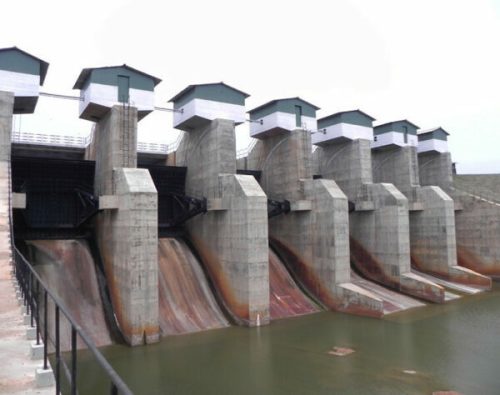
05. Yala Beach
Yala Beach is a stunning coastline located within Yala National Park. Located adjacent to the Palatupana Gate, with leisure amenities. During the lengthy bumpy safari, most safari jeep drivers allow the guests to get down from their jeeps, stroll on the sandy beach, and relax a little.
Yala Beach is completely wild, with no facilities for swimming or even normal resort activities. A powerful current rushes near the coast, dragging inexperienced swimmers into the water. On the seashore here, special flags warn of danger, and the area is monitored. Water sports, starting fires, and erecting tents are all forbidden.

06. Tsunami memorial in Yala
Tsunami memorial is built where the Patangala Rest House was demolished by the 2004 tsunami that ravaged the Sri Lankan coast. The Tsunami memorial was created in commemoration of the 47 tourists who died at this precise location, and the tourists who lost their lives are still remembered.
Only the foundation of the rest house remains, and a memorial monument has been constructed to remember the 47 individuals who died on the site. The sculpture depicts the tsunami waves that hit the region as well as the amount of water following the tsunami.

07. Manik River Natural Pool
Manik River Natural Pool is situated on the Buttala-Kataragama road and is regarded as one of Yala’s top natural swimming pools. It serves as a recreational pool for the locals. This is the ideal place to unwind if you want to take a natural bath and live like a local after a challenging Bumpy Safari Ride.
The area is rarely crowded in the afternoon and has an ominous look due to the surrounding old trees. If you enjoy taking a bath in the forest, this location is perfect for you. As you swim, keep an eye out for the sharp rocks that clutter the bottom. As the location is inside the Yala National Park and frequented by native elephants and leopards, always make sure to travel with a local guide.

08. Kirinda Beach
A calm location in the middle of a fishing village, Kirinda Beach is within a 10-minute stroll from the Kirinda Buddhist Temple and 20 minutes’ drive from Yala National Park. The Kirinda beach, however, is crowded with locals who come to spend their spare time nearby on weekends and local holidays. Because of the high frequency of drownings reported, swimming is not advised. Further exploration of the beach reveals a number of gift stores offering tiny seashell-crafted souvenirs.
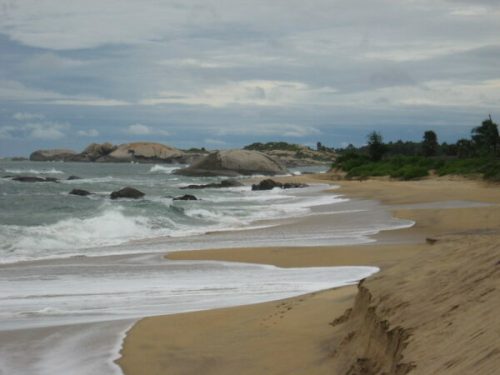
09. Kebilitta Devalaya
Kebilitta Devalaya, which is located on the banks of the Manik Ganga, is revered by the people. A regenal god named Kataragama Deviyo is believed to now reside at the Kebiliththa Devalaya. The shrine’s only feature is a nine-foot-tall, old tamarind tree, where Kataragama Deviyo is said to be resting. Devotees spend weeks or months preparing before visiting this holy site by doing routine prayers, receiving blessings, and fasting from animal products, alcohol, and smoking. If not, it is firmly believed, they would be unable to reach the hallowed location and would face several hazards. As it runs through the deep Yala block IV woods, muddy areas, through rivers, and other tough terrain, the route to the Devalaya is not easy.
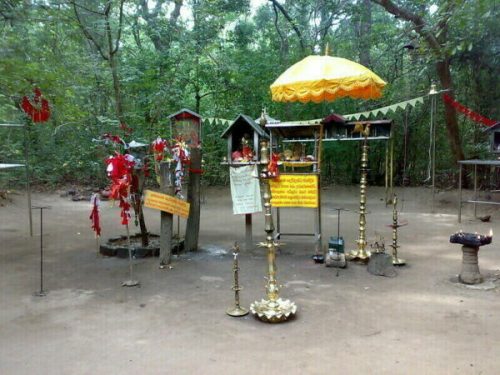
10. Palatupana Saltern
The palatupana saltern is one of three salterns owned by Hambantota Maha Levaya. The salt produced here is marketed under the brand name ‘Lak Lunu.’ Hambantota Maha Levaya originated as a department in 1938 and became a corporation in 1957 when three salterns, Maha Levaya, Bundala, and Palatupana, merged.
Palatupana Satlern is not only widely renowned for its salt, but it is also highly recognized among bird watching crews since it is constantly busy with migrating birds.
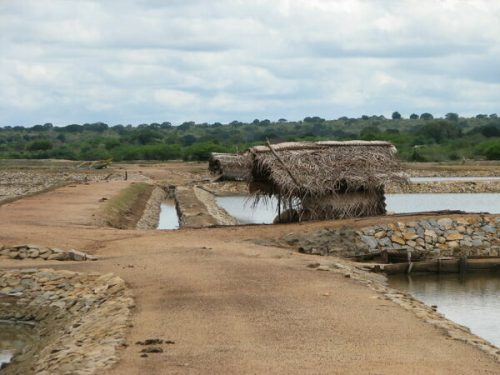
Yala is easy to explore on your own. However, if you don’t have time to research and organize your trip, or if you simply prefer to leave the painstaking planning to the pros, you’ll be glad to hear that there are some outstanding guided tours organised by Ceylon Hunt that includes guided jeep safari in Yala national park and the surrounding Places to visit in Yala.
Image courtesy of firesock, Clarence Cooray, Davida De La Harpe, direndesilva, gaminivijithsamarakoon, Vidarshi, Felix Krohn, Falco Ermert, Michael Shehan Obeyseker via creative commons licenses. some rights reserved.
We hope you enjoyed this blog on Best Places to See in Yala National Park, Sri Lanka!. If you have any questions or wish to book a Taxi in Yala National Park please send us a message on our website or leave a comment below so that we can respond!


